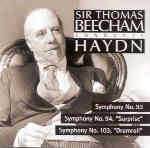Thomas Beecham’s Haydn remains incomparable in its unfailing response to the composer’s wit, charm, and elegance. Despite the fact that his approach might be considered “old fashioned” by today’s standards, with trumpets and drums (except in Symphony No. 93) largely conspicuous by their retiring nature, and interpretations marked by the use of corrupt editions (no solo string quartet at the beginning of Symphony No. 93’s slow movement; the conventional “swell” opening the “Drumroll” symphony; some odd passages played pizzicato that Haydn never intended) these performances command attention for several important reasons.
First, however anachronistic the balances may be, Beecham achieves remarkable clarity of texture, even in these (excellently remastered) earlier mono renditions from the beginning of the 1950s (his later EMI remakes offer virtually identical conceptions and surely deserve transfer to the label’s Great Recordings of the Century series without delay). No passage of melodic importance goes unnoticed–bass lines always receive the same shapely treatment as the musical surface–and all three minuets offer countless details of color and character.
Second, these performances simply must be heard by anyone who believes that the most important distinction between interpretations by different artists involves variations in tempo. To be sure, tempo isn’t Beecham’s principal point-making tool: what matters to him are phrasing, dynamics, rhythm, and accent. Concerning dynamics alone, Beecham offers a veritable treatise, with no opportunity lost to guide the ear through a phrase to its point of resolution. Take for example his handling of the opening of Symphony No. 93, or the tiny swells and dynamic adjustments in his playing of the opening tune of No. 103’s finale.
What’s even more important than the fact that Beecham adds all of these details to the comparatively blank slate of Haydn’s score (even in the corrupt editions), is that 99 percent of the time what he does is entirely consistent with the expressive content at hand. In other words, his ideas aren’t pasted on to the music, but support and enhance it, revealing a deep understanding of Haydn’s style allied to superb taste. Even where his approach doesn’t work particularly well (as in the fussy trumpet and drum fanfares in the Minuet of Symphony No. 93), the result never sounds dull or unmusical.
Finally, and perhaps most significantly, Beecham achieved these miracles of subtlety through detailed marking of parts, reminding us that in many cases a conductor’s careful preparatory work has a far greater impact on what happens in performance than any amount of stick waving from the podium in real time (indeed there often is more going on in terms of nuance and shading than the finest stick technique could possibly communicate in concert). The flow, sense of inevitability, spontaneity, and infectious joy that Beecham communicates have no basis in Romantic theories of “inspiration of the moment” and specious generalizations about the differences between “live” and “studio” recordings. They are the result of extraordinary care in preparation, truly “the art that conceals art.” In short, these are performances from which music lovers, performers, and scholars alike can still learn from and enjoy. They are true classics.
































